The aim of this page is to provide swimmers, parents, child care providers and other swimming pool patrons with a few guidelines to help them determine if the lifeguards at the pool they go to are doing their jobs properly.
When on duty, a lifeguard should be ready to make any needed rescue.
At a California University, a lifeguard on duty using her rescue tube as a footrest instead of having it in her lap, ready for use. My students tell me they have seen guards at this facility with their feet on their rescue tube AND talking on a cell phone. The lifeguards are often on duty alone and responsible for an entire olympic sized pool, about 25 yards by 50 meters.
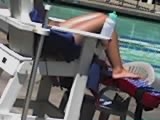
This lifeguard was on duty at a national park pool, again, not ready to make a rescue:
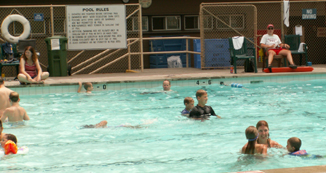
As I watched this pool briefly I saw two other guards demonstrate that they were bored: one was twirling his whistle, and another absentmindedly tapped her rescue tube in her lap as if it were a bongo drum.
When some of these guards changed positions they did not make certain that the pool zone was being watched by at least one of them the whole time.
_________________________________
When trading places/stations
(rotating from lifeguard stand to stand or bringing in a new lifeguard when one on duty goes on a break),
patron surveillance must always be maintained. The first photo below shows a guard on duty and the replacement guard standing by the lifeguard stand. The replacement guard takes over watching the pool while the guard at the station climbs down from the stand, then starts scanning the pool again. The second guard can then get into position on the lifeguard stand and take over scanning. The guards can exchange any important information, such as a swimmer who needs to be watched more closely.
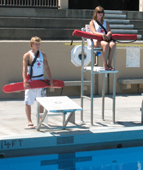
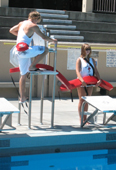
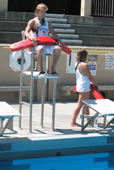
_________________________________
Lifeguards should not hold social conversations while on duty.
Ken Mignosa took this photo Saturday, July 22, 2006 at the JSSL (Junipero Serra Swim League) Championships his son was competing in.
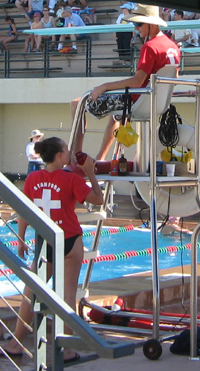
In 2012 (and other editions) American Red Cross Lifeguarding we read:
“While scanning, do not be distracted by people or activities.
Keep focused on the assigned area of responsibility.”
and
“Distractions … affect patron surveillance, for example, a lifeguard talking to other lifeguards or friends. A brief conversation might seem innocent, but during that time a 20 to 60 second struggle of a young child could be missed. The child could die because a lifeguard was distracted! Social conversations should not be held while on duty.”
_________________________________
Safety rules must be enforced even if they are unpopular with pool patrons.
A lifeguard staff manual said:
“Preventative guarding is the key. Yelling “no diving,”
may get tiresome, but doing a backboard rescue is worse. Anticipate dangerous situations and
prevent problems.”
“Be aggressive and consistent. Assume control and never relinquish it. Be strict and never let
down. Your job is important and you must maintain your authority.”
Many pools have a rule that many parents don’t understand:
no waterwings or floaties
The reasons for this rule are that
1) the waterwings can make the parents/guardians overconfident
2) the waterwings can make the child overconfident
Photo below taken at a pool with no rule banning waterwings or requiring a parent to stay next to a child who depends on them
OR perhaps a rule that was not being enforced?
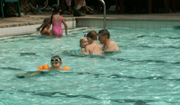
3) and if they slip up to the child’s wrists, they can hold the child underwater. The child will often not have the strength to pull themselves up to where they can breathe. Even a few seconds of this is too many. (The photos below were posed. Sean is a good swimmer who can hold his breath for quite awhile.)
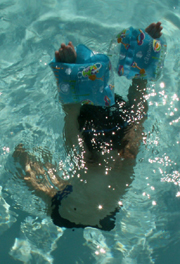
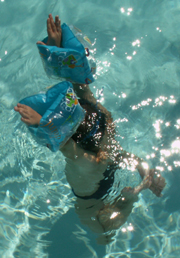
Some pool rules you might expect to find are at: pool rules: attire, health and sanitation, spas rules, pool rules concerning children, diving board and slide rules, general pool rules
_________________________________
Does the manager watch the guards?
Below a picture of a pool office with big corner windows that would allow the manager to watch the guards/patrons/lessons, except that it has so many flyers posted in the windows, and a big display just outside, that the view through all three windows is blocked.

_________________________________
Starting blocks should not be placed where inexperienced people could hurt themselves if they were tempted to try to use them, or steps should be taken to prevent their use.
The Red Cross says, in the lifeguard training manual,
“The following guidelines will help prevent head, neck and back injuries:
…place starting blocks above deep water (at least 9 feet deep).”
Starting blocks are a temptation (an attractive nuisance) and should be removed when not in use by swim team members, or have solid rounded covers placed on them to prevent people from using them.

In the picture above, the starting blocks are placed over seven feet deep water, and the one in the lane closest to the shallow water is very near where the pool bottom slopes to less than 5 feet. An inexperienced diver who attempted to use this starting block and slipped or otherwise performed a dive not straight out could hit his head on the bottom slope.
_________________________________
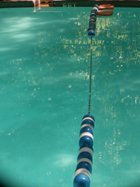 The lifelines at these pools at hotels in a National Park somewhat fulfill the need to mark the dropoff from shallow to deep water. But because there are not enough floats and they are not evenly spaced, it would not be strong enough to support a distressed swimmer, so it would not save a life as it is supposed to if someone needs to grab it.
The lifelines at these pools at hotels in a National Park somewhat fulfill the need to mark the dropoff from shallow to deep water. But because there are not enough floats and they are not evenly spaced, it would not be strong enough to support a distressed swimmer, so it would not save a life as it is supposed to if someone needs to grab it.
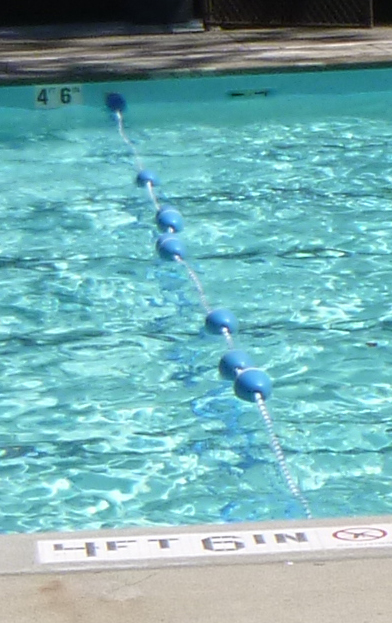
_________________________________
(from the Red Cross Water Safety Instructor’s manual, 2009) Minimum depth of water under a 1 meter diving board directly under the tip of the board should be 11 feet 6 inches. Minimum depth to teach diving from the side of the pool is 9 feet. Goggles should never be worn during teaching of head first entries.
By any standards, the diving board pictured below is not safe because the water below it is not deep enough:
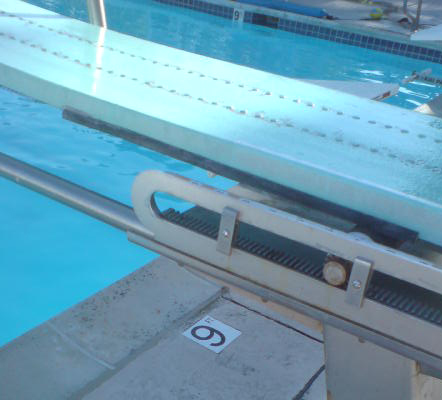
_________________________________
Guards need to guard from stands or the edge of the deck where they can see the whole surface and the entire bottom of the area they are responsible for.
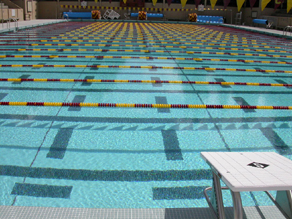
Many large racing pools are 25 yards by 50 meters. When standing at one end the lanes lines at the other end blend into each other and a swimmer at the surface or at the bottom can’t be seen clearly. One guard is not enough, as there is no place a guard can be stationed, even up on a elevated lifeguard stand, where they can see the whole pool.
_________________________________
Here’s a job offer on Craigslist:
“Certified Lifeguard at Private Club
Date: 2006-11-27, 1:50PM
XYZ Tennis & Swim Club is looking for a CPR, first aid and water safety certified lifeguard for hours at the xyz Rec pool in Xyz Valley. Hours are flexible, however we are primarily looking for morning (approximately 7 – 9am) or evening hours (6 – 8pm). There may be a need for some mid-day and weekend hours as well if you are interested.
Duties include opening and closing the pool, signing-in and supervising recreational lap swimmers, covering the pool at night, testing the pool chemicals at least once during a shift, and some light maintainence.
The pool is located in a quiet rural area, and there are usually no more than 4 – 5 lap swimmers in the pool at a time. There is also a large pool office from which the pool can be monitored during bad weather. ”
The management is clearly overconfident that these 4 to 5 lap swimmers won’t need any help.
_________________________________
One of the main reasons a person might drown at an area where a lifeguard was on duty is the intrusion of secondary duties on the lifeguard’s primary responsibility of patron surveillance. Guards on duty should watch the water and patrons, not sweep the deck, pick up towels, check water chemicals, etc. I watched a lap swim guard who was the only guard on duty leave his stand near the end of the scheduled swim time. He wanted to be able to leave promptly and he put away a timing clock and other gear, leaving the swimmers unsupervised.
_________________________________
Guards on duty should not just sit and stare out into space. You should at least see their head move back and forth, looking at the entire surface and all of the bottom of the section of pool they are guarding.
_________________________________
The pictures below of guards not doing their jobs were posed, not taken while on duty:
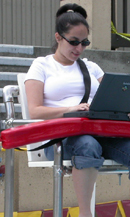
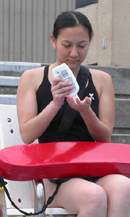
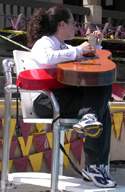
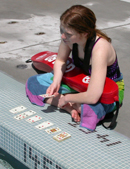
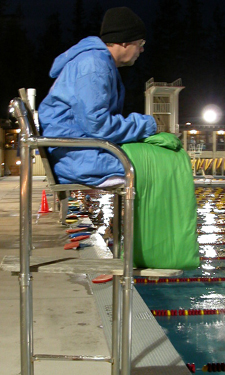
_________________________________
It is a violation of the health code to have a dog on the pool deck or in the pool.
_________________________________
CPO What a certified pool operator (CPO) knows that lifeguards and swimmers should know.
lifeguard training, discussing professionalism is an in-service training project, or perhaps for pool patrons, lifeguard candidates who look at this page to consider on their own.
__________________________________________________________
Get ready for lifeguard training.
____________________________
——————————————————————-
The author of this webpage, (written as a reading assignment for my students), does not give any warranty, expressed or implied, nor assume any legal liability or responsibility for the accuracy, completeness, or usefulness of any information, product, or process included in this website or at websites linked to or from it. Users of information from this website assume all liability arising from such use.